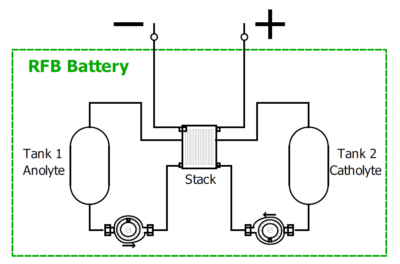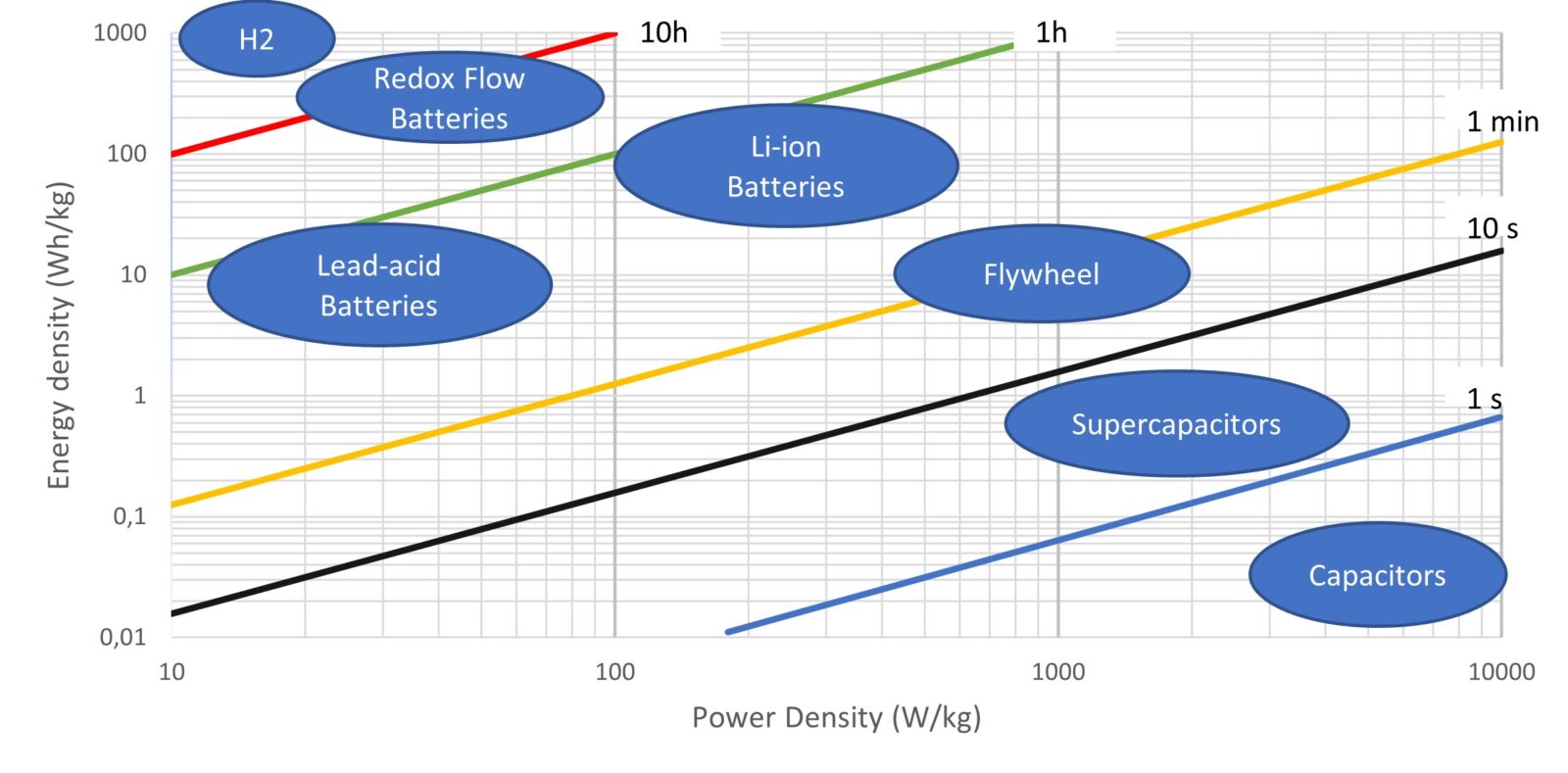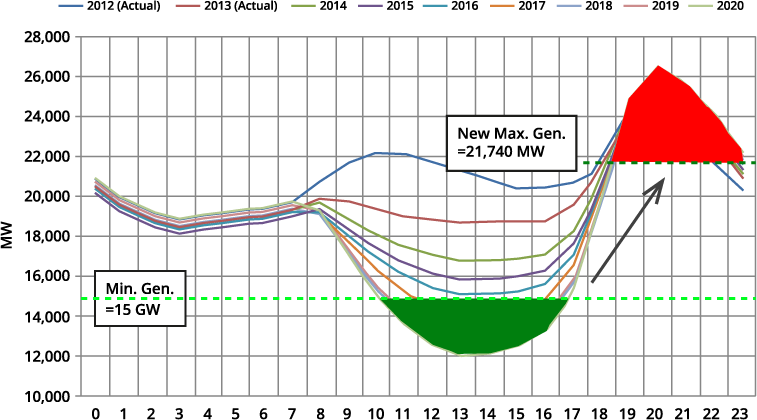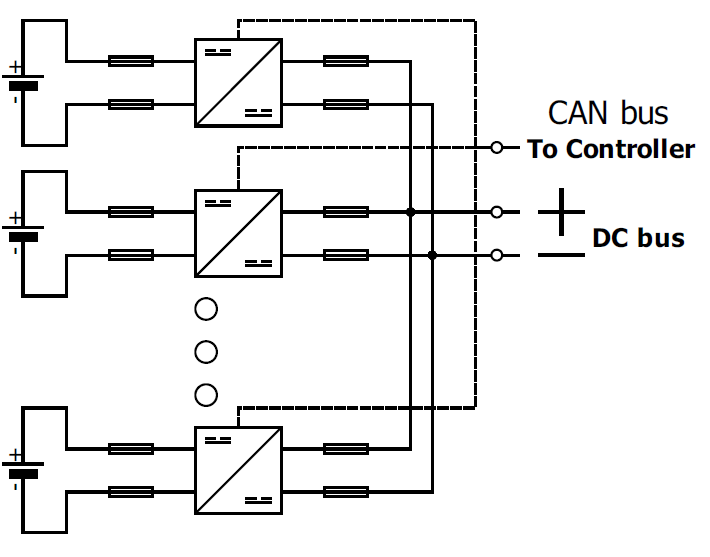1. Redox Flow Battery overview
A Flow Battery is a type of rechargeable fuel cell where one or more dissolved electroactive elements flow through a cell to convert chemical energy into electricity.
The electrochemical elements that act as the anolyte and catholyte do not have physical contact between each other and produce electricity through a REDOX (reduction-oxidation) process. In this process ions are transferred through the membrane in the cell to drive the anolyte and catholyte into other reduction/oxidation states.


The economic effectiveness of the flow battery stems from the clear advantage it holds in terms of cost-efficiency. The separation between energy and power characteristics plays a pivotal role in making the flow battery highly favorable for high-energy, low-power applications. This is primarily due to the simplicity and affordability of expanding the volume of electrolyte, which enables the flow battery to deliver significant energy capacity without incurring substantial costs.
Figure 2 shows the most common energy storage technologies in a distribution of energy and power density and time of charge/discharge required.
Depending on the electrochemical elements used, the voltage in each one of the battery cells will be higher or lower. Below, Table 1 shows the most common RFB combinations.
| Electrochemical elements | Max voltage per cell (V) | Power Density (W/m2) |
| Iron – Iron | 1.8 | < 1200 |
| Zinc – Bromine | 1.85 | – 1,200 |
| Vanadium – Vanadium | 1.60 | – 1000 |
| Iron – Chromium | 1.2 | < 600 |
As the voltage per cell is too low to be practical, several cells must be stacked to build a usable battery. Depending on the electrochemical elements used, the targeted application and the voltages of operation desired, more or less cells can be stacked. Standard numbers normally range between 20 and 50 cells.
Increasing the number of cells in series reduces the efficiency caused by shunt currents and creates imbalances between the cells. Therefore, the number of stacked cells does not generally go beyond 50. Considering the standard electrochemical elements from Table 1, each stack of 40-50 cells would have a voltage range between 40 and 80 V.
2. Redox Flow Batteries and its place on energy transition.
The energy transition from fossil fuels to renewable energies is the main driver for the development and implementation of new high-energy density energy storages. Redox Flow Batteries are playing an important role now and will be in the future.
With the increase of renewable sources such as solar and wind, the shape of the net load (net load = total electric demand minus wind and solar generation) has been changing in the last few years. To have a flat net load and avoid a duck curve shape as depicted in Fig.3, an energy storage capable of shifting the load is needed.
As seen in Fig.3, the drop in the net load is found between 9 am and 5 pm while the load increase is found between 5 and 11 pm. This behaviour is repeated along the year with more or less impact depending on the consumption and generation patterns.
Such grids would benefit greatly from the use of a battery capable of shifting the load. Redox flow batteries (RFB) are optimally dimensioned for an operation of between 4 and 9 hours as the power and energy are uncoupled with the energy cost much lower than the power cost.
Other uses of Redox flow batteries (RFB) that benefit the operation and stability of the grid below:


| FUNCTIONS OF REDOX FLOW BATTERIES | COMMENTS |
| BALANCE OF GRID SUPPLY AND DEMAND | RFB can help balance supply and demand on the scale of 4-12 hours. Also, the response time is in the range of seconds to work on short-term regulation. |
| SHIFTING ELECTRICITY NET LOAD | RFB can charge when renewables produce and discharge when the load and prices increase. |
| REDUCTION OF ANCILLARY SERVICES AND DEFER INFRASTRUCTURE INVESTMENTS | Well distributed energy storage can support the grid stability on the nodes of distribution. |
| BACK-UP POWER | Operation in island mode during outages in local areas. |
3. Bidirectional isolated DC/DC converters. Why use them?
Converters capable of dealing with high currents and voltages are required to connect low-voltage Redox Flow Battery (RFB) stacks with industrial voltages (400-690 Vac).
Our isolated power converters ensure the most efficient and cost-effective solution to overcome the high-voltage gap between the RFB stack and the standard grid voltages. These converters are designed to operate at very high currents on the RFB side and high voltages on the other side with over 95% efficiency.
As Flow Battery stacks can normally deal with powers between 5 and 15 kW, several stacks need to be installed together to offer solutions of MW size. To parallelize the stacks and avoid common mode currents between the stacks, galvanically isolated converters connected to each or a few stacks in parallel are required.
Manufacturers of RFB are standardizing the solutions by building 20’ or 40’ containers including the stacks (power), the tanks of electrolyte (energy) and the power electronics. An all-in-one plug&play solution as exemplified in Figure 5.

As the operation of the standard RFB are bidirectional, storing energy for certain hours to return it when it’s needed most, a bidirectional isolated DC/DC converter is required. The connection to the grid is accomplished by means of an inverter in each container or, alternatively, through a centralized inverter for the installation.
4. Redox Flow Batteries. Role and operation of the DC/DC converters.
Epic power’s DC/DC converters can be parallelized on one side (high or low side) or both sides. The electrical connection is done directly at the electrical point that they are expected to control in parallel while the communication between each unit is done via CAN bus.

In Figure 6, a general configuration of several converters in parallel on the high-voltage side is presented. The CAN communication of the converters is connected to the external controller of the application.
For each converter to be controlled individually, the user must configure them with different ID numbers. Up to 16 units in the same CAN network are accepted in the standard CAN protocol.
The two control modes that are most used in Redox flow batteries (RFB) applications are:
- Voltage regulation of the high-side: A voltage reference at the high-voltage side is given to the converter with limiting voltage levels on the low-voltage side. The converter will regulate the DC bus at the high-voltage side while the battery is within the specified range. As the converter measures the voltage every few microseconds and no additional communication is required to start providing or absorbing power, the reaction time is short.
- Current/power regulation of the low side: If the DC bus is already regulated by an external element. The controller of the installation can control the charge or discharge of each individual stack. Changes in the current/power setpoint are slower than in the voltage control.
As a summary, the Table 3 presents benefits and drawbacks of each control is introduced.
| Inverter | DC/DC converters | Benefits | Drawbacks |
| Regulates DC Bus | Regulate current or power on the RFB | Control over current & power output per stack | Increases reaction time |
| Regulates Power output | Regulates DC bus on the high side | Very fast response. Ideal for grid support | Reduction of control of power per stack |
5. Redox Flow Batteries. Conclusions.
The Redox Flow Batteries provide several benefits to the energy transition towards renewable energy use. RFBs, with their optimal operation between 4 and 12 hours can help to shift the net load of the grid and avoid curtailment situations and big fluctuations in energy cost.
As RFB cells can only be stacked in low number to avoid increasing the complexity and the losses of the stacks, isolated bidirectional DC/DC converters need to be used to step-up the output voltage. The power electronics and especially the DC/DC converters must be able to regulate the output voltage precisely with a quick reaction time. That is critical to maximize the functions and benefits the RFBs can offer to grid operators.
Epic power technology of bidirectional isolated DC/DC converters is prepared to perform the operation expected out of redox flow batteries with the highest possible efficiency and control versatility.
Actually we are working in the european project (Hyflow) as System designers and developers of bidirectional DC-to-DC converters for hybridation of different systems
You can download here the full document: AN058 – Redox Flow Battery. Implementation of bidirectional DC/DC converters
[1] Power consumption – Net Load – Energy Storage and the California “Duck Curve” (stanford.edu)
